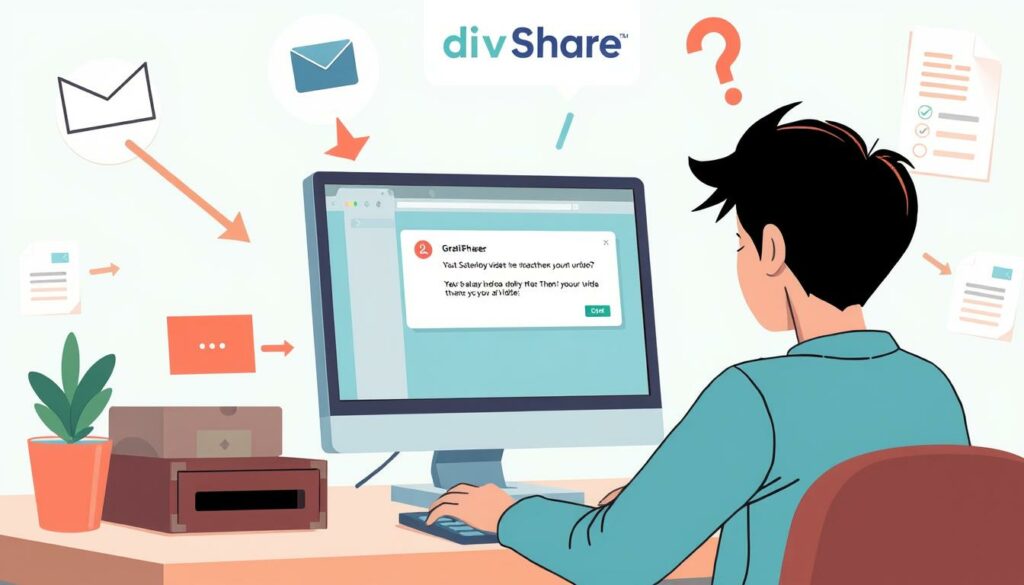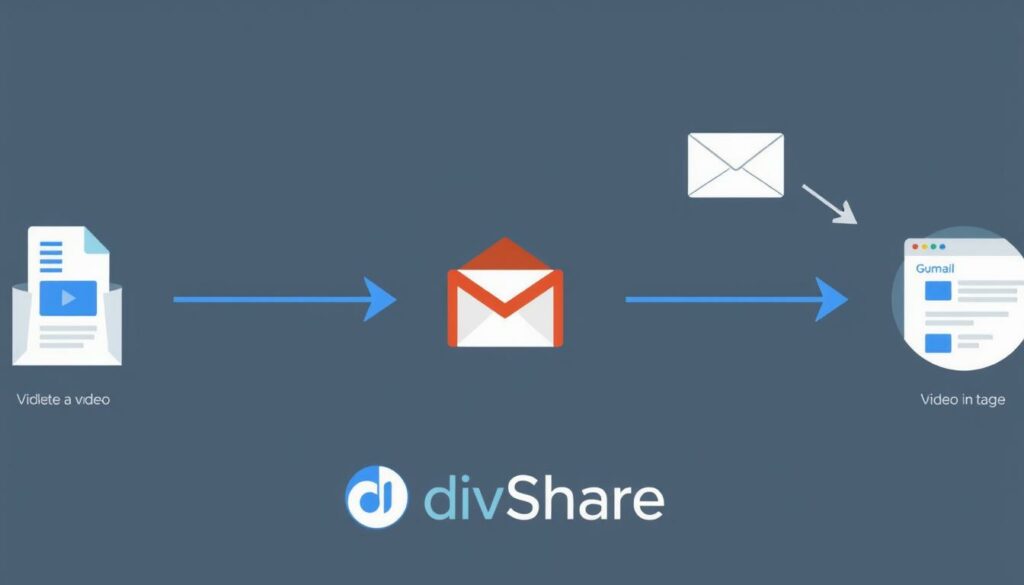How To Embed a Video in Gmail – A Simple Solution
In today’s digital age, the ability to embed video in Gmail has become a game-changer for effective communication. With the rising demand for visual content, mastering Gmail video embedding can set you apart in a crowded inbox.
Did you know that adding “video” to your subject line boosts engagement by 6%? That’s just the tip of the iceberg when it comes to the power of video emails. While Gmail’s 25MB attachment limit can be a hurdle, there are smart ways to insert video in Gmail email without compromising quality.
Ready to transform your Gmail communication strategy? Let’s explore how you can leverage video emails to stand out in your recipients’ inboxes.
Understanding the Importance of Video in Email Communication
Video has revolutionized email communication, transforming messages into engaging experiences rather than static text. Features like Gmail’s video preview make content more enticing by allowing recipients to glimpse your message before opening it.
Statistics highlight the video’s effectiveness. Including “video” in a subject line can boost open rates by 19%, while a video thumbnail increases click-through rates by 41%. Furthermore, 64% of users are more likely to make a purchase after watching a video. This makes video a key tool in today’s digital landscape.
Videos don’t just stand out in crowded inboxes — they make outreach personal and significantly boost engagement. Research shows that 69% of consumers prefer learning about products through videos, and embedding videos in emails can reduce unsubscribes by nearly 26%. For businesses, video embedding is invaluable for effectively sharing large files or presentations.
The impact of video on email communication is undeniable. By embracing this tool, you can transform how you connect with your audience, drive engagement, and achieve better results.
Common Misconceptions About Embedding Videos in Gmail
There are several misconceptions about sharing videos in Gmail that can lead to confusion or missed opportunities.
- Attaching videos or sending links is always the best way to share videos.
While it might seem convenient, attaching large video files or sending links can cause problems. Spam filters often flag large video attachments, and email size limits can prevent sending them. Additionally, recipients may hesitate to click on links if they appear unsafe. - You can’t embed videos directly in Gmail.
While it’s true that Gmail doesn’t allow direct video embedding (like an inline playable video), you can still share videos effectively. Using a video thumbnail or an animated GIF linked to your video can drive higher engagement. Emails with video content achieve a 5.6% higher open rate. Additionally, they have a 96% higher click-through rate compared to emails without videos. - All email clients support video playback.
Not all email clients can play embedded videos. Gmail and Outlook, for example, do not support embedded video playback. However, this doesn’t mean you can’t include videos in your emails. Using a video thumbnail that links to an external video or including animated GIFs are great alternatives that work across most email platforms.
The Technical Limitations of Direct Video Embedding in Gmail
Gmail users often struggle to embed videos. This is because Gmail doesn’t support direct video embedding, which is due to performance and security concerns. Other big email clients like Outlook and Yahoo also face this issue.
Even though some email clients, like Apple Mail, support the HTML5 video tag, it’s not everywhere. This makes it hard to share videos directly through Gmail. Studies show that most email service providers, including Gmail, won’t play embedded videos. Instead, they show a fallback image.
Some email clients do support embedded videos, including Apple Mail, Outlook for Mac, and Thunderbird. However, Android, AOL Mail, and Yahoo! Mail usually show a fallback image, making it tricky to embed videos reliably in Gmail.
Despite these challenges, video content is key in email marketing. Almost half of all global businesses use videos in emails to improve conversion rates. Using the word ‘video’ in the subject line can boost open rates by 19% and cut down on unsubscribes by 26%. These stats show why finding ways to share videos through Gmail is important.
How To Embed a Video in Gmail: A Step-by-Step Guide
Embedding videos in Gmail can significantly boost engagement, leading to a 19% increase in email opens and a 65% increase in clicks. Here’s a simple guide to help you embed videos in your Gmail emails using a third-party tool like Covideo:
- Go to the Chrome Web Store and download the Covideo extension.
- Open Gmail and click on the “Compose” button to start a new email.
- In the compose window, click on the Covideo icon that appears in the toolbar.
- Choose a video from your Covideo library or upload a new video.
- You can select a custom landing page for the video and add calls-to-action (CTAs) to make the video more engaging.
- Once you’re happy with the setup, click the “Insert Video” button to add it to your email.
- The video will appear as an animated GIF thumbnail in the email body. This thumbnail links to a custom landing page where the full video plays.
- This method works well across platforms, but keep in mind that not all email clients support embedded videos.
Bonus Tip: If you’re planning to send large files along with your video, you can ZIP a file to compress it before attaching it to your email. This will make the process smoother and more efficient.
By following these simple steps, you’ll be able to embed videos effectively in your Gmail messages, making your emails more engaging. To further boost performance, remember to use clear call-to-actions and relevant subject lines!

Alternative Methods for Sharing Videos via Gmail
Gmail may not support direct video embedding, but there are several smart ways to share videos effectively:
- Use YouTube or Vimeo Links: Simply paste a YouTube or Vimeo link into your email. This generates a clickable preview, allowing recipients to access the video effortlessly.
- Overcome Size Limits: For videos larger than Gmail’s 25 MB limit, Gmail converts them into Google Drive links automatically. For even larger files, consider cloud storage options like Dropbox or OneDrive to ensure recipients can easily view or download the content.
- Leverage GIFs: GIFs are a great alternative for short clips. They autoplay in most email clients, grabbing attention instantly. You can also create screen recordings, convert them to GIFs, and share them seamlessly.
- Optimize with Thumbnails: Add a visually engaging thumbnail linked to your video. Thumbnails can increase click-through rates by up to 80%, making them a powerful tool for boosting engagement.
- Enhance Subject Lines: Including the word “video” in your email subject line can boost open rates significantly. Studies show that videos can increase click rates by as much as 300%, making them a valuable addition to your campaigns.
- Keep Videos Concise: To maintain viewer interest, keep videos under 30 seconds and focus on your message.
- Use Personalization: Personalized videos, such as thank-you messages or special greetings, create a deeper connection with your audience. Adding subtitles ensures accessibility for all recipients.
- Include Clear CTAs: Guide your audience with actionable steps, such as “Watch Now,” “Learn More,” or “Visit Our Website.”
By applying these methods, you can effectively share videos through Gmail without embedding them directly, transforming your email marketing strategy into a more engaging and impactful experience.

Using Third-Party Tools To Enhance Video Email Experience
Gmail video embedding has evolved, but inserting videos directly still has its challenges. Third-party tools offer a solution to make video insertion in Gmail emails seamless. These platforms provide features that go beyond Gmail’s limits, offering an engaging video experience.
Services like Covideo, Biteable, and Wistia offer custom landing pages, call-to-action buttons, and video analytics. They help embed videos in emails, boosting open rates by 6% and click-through rates by 65%. With these tools, you can create screen recordings, use mobile apps, and trim videos to perfection.
Marketers who use video in their campaigns see revenue growth 49% faster than those who don’t. Yet, only 34% of marketers currently use video embedding in emails. By using third-party tools, you can join the ranks of successful marketers and boost your email campaigns with compelling video content.
Remember, videos in emails should be under 10 MB and no longer than 90 seconds. Use engaging thumbnails to increase click rates. With the right tools and strategies, you can create powerful video emails that resonate with your audience and drive results.
Best Practices for Video Email Marketing in Gmail
Using video in Gmail emails can really boost your engagement. When you add a video, you make your emails more interactive.
- Start by using eye-catching thumbnails with clear play buttons to grab attention.
- Keep your videos short and to the point, ideally 2-3 minutes. This helps keep your audience engaged.
- Adding “video” to your subject line can increase open rates by 19%, Hubspot says.
- Make sure to tell viewers to click and watch the video. Your video should deliver on the email’s promise to build trust.
- After the video, include a strong call to action. This guides viewers on what to do next.
- Optimize your video landing pages for conversions. Test different video styles and lengths to see what works best. Videos in emails can increase click-through rates by up to 300%.
By following these tips, you’ll create video email marketing campaigns that get results.
Troubleshooting Common Issues When Embedding Videos in Gmail
Sharing videos in Gmail can increase engagement by up to 300%. But, it comes with its own set of problems. Users might find videos not playing or large files causing delivery issues. To fix these, use trusted third-party tools and make your video files smaller.
Gmail has a 25 MB limit for attachments. So, Google Drive links replace big videos. This prevents others from seeing your emails as spam. For the best viewing, stick to formats like MP4 or MOV. If videos don’t play well, suggest checking the internet and browser cache.
Before sending out video emails, test them thoroughly. Ensure your video works on all devices and email clients. If you’re embedding in HTML, add a fallback image for those who can’t play videos. These steps will help your video content shine in Gmail.
Make Every Email Count – Embed Videos Seamlessly With DivShare!
Embedding a video in Gmail is a straightforward way to make your emails more engaging and visually appealing. By either using a direct link, a clickable image thumbnail, or embedding the video through a service like YouTube, you can easily share video content with your recipients.
Remember to keep the video relevant, concise, and optimized for quick loading to ensure a seamless experience for your audience. With these tips, your emails can stand out and communicate your message effectively.
Ready to make sharing your media seamless and efficient? Sign up with DivShare today and simplify how you store, share, and embed videos directly into your emails. Start for free and elevate your content delivery now!